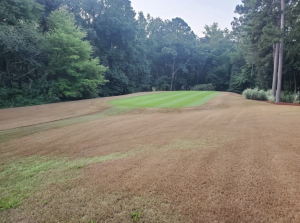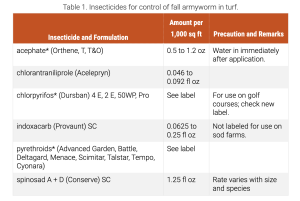Fall armyworms are a persistent threat to turfgrass, especially in the Southeastern United States, where warm temperatures and humid conditions create an ideal environment for them. These pests are notorious for their ability to cause significant damage to lawns, athletic fields, and golf courses, and cause a stark contrast between damaged and undamaged areas. Understanding how to prevent and treat fall armyworm infestations is crucial for maintaining healthy, vibrant natural turfgrass.
Identifying Fall Armyworm Damage
One of the most telltale signs of fall armyworm damage is the noticeable line that forms between healthy and damaged turfgrass. This line often appears because the armyworms consume the grass blades, leaving behind a clear demarcation between affected and unaffected areas. The damage typically begins near a site where the armyworms’ egg masses have been laid, such as around lights, trees, or structures, and radiates outward as the larvae move in search of more food.
Newly-installed sod is particularly vulnerable to fall armyworm damage. The fresh, tender grass provides an ideal food source for the larvae, making it more prone to infestation. For this reason, homeowners and turf managers should be especially vigilant during the fall when armyworm activity is at its peak.
Choosing the Right Turfgrass: Zeon Zoysia
One of the most effective strategies for preventing fall armyworm damage is to choose a turfgrass variety that is naturally more resistant to pests. Zeon Zoysia is an excellent choice for this purpose. Known for its superior resistance to a variety of pests, including fall armyworms, Zeon Zoysia provides a strong defense against infestations. This grass variety is not only resilient but also offers a beautiful, dense coverage that is ideal for both residential lawns, commercial landscapes, and golf courses.

Treatment and Prevention Strategies
Even with pest-resistant turfgrass, it is essential to implement additional prevention and treatment measures to protect your lawn from fall armyworms. Here are some strategies to consider:

1. Early Detection: Regularly inspect your lawn, especially during the late summer and early fall, for signs of armyworm activity. Look for the distinctive line between healthy and damaged grass and check for the presence of larvae or egg masses.
2. Timely Treatment: If you notice signs of an armyworm infestation, act quickly. Applying an appropriate insecticide can prevent further damage. For newly-installed sod, it is recommended to treat the lawn within one week of installation to minimize the risk of infestation.
3. Maintain a Healthy Lawn: A well-maintained lawn is less susceptible to pest damage. Regular watering, mowing, and fertilization can strengthen your turfgrass, making it more resilient to infestations.
4. Use Treated Sod: When installing new sod, choose sod that has been pre-treated for pests. Many sod farms, including ours, treat their fields to reduce the risk of fall armyworm infestations. However, it is still crucial to follow up with a treatment soon after installation to ensure maximum protection.
Fall armyworms can cause significant damage to turfgrass, but with the right prevention and treatment strategies, you can protect your lawn from these destructive pests. By choosing resistant grass varieties like Zeon Zoysia, maintaining a healthy lawn, and acting quickly at the first sign of trouble, you can keep your grounds looking lush and beautiful all year round. For more expert tips on preventing and managing fall armyworm damage, visit www.sodstar.com.
